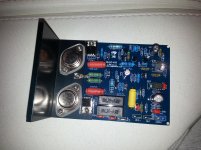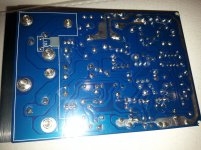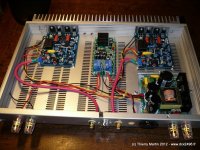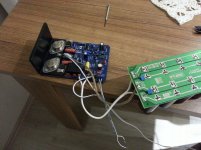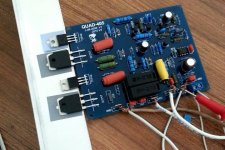Here the board.
I have 2 boards and one of them starts oscillating after a minute and the other oscillates when plugging.I have not built a case for the amplifiers.Do you think it can be a problem?Should i connect gnd to amplifier chasis?
I have 2 boards and one of them starts oscillating after a minute and the other oscillates when plugging.I have not built a case for the amplifiers.Do you think it can be a problem?Should i connect gnd to amplifier chasis?
Attachments
Last edited:
You already have a thread for this problem from last year and it is important to show what you have already tried. Otherwise, you will be wasting people's time coming up with the same suggestions.
http://www.diyaudio.com/forums/solid-state/245162-quad-405-clone-oscillation.html
http://www.diyaudio.com/forums/solid-state/245162-quad-405-clone-oscillation.html
I've got the same issue with a Quad 909 clone. One channel works flawlessly the other oscillates. I'll be interested to see if you cure yours.
http://www.diyaudio.com/forums/solid-state/206460-quad-909-clone.html
http://www.diyaudio.com/forums/solid-state/206460-quad-909-clone.html
The last "fix" has both channels oscillating according to #8 in the other thread:
.....Now i saw a problem with solder of 120pf cap and fixed it.Now the other channel also started to play.It sounds good at startup and oscillated after about a minute too.Now both amps have same problem.I have not added 100nf cap yet.....
I am surprised to hear about oscillations. LJM's clone board is probably identical to oldest version of 405 including the same low grade opamp. So, probably additional decoupling of opamp is not necessary for stable work. If I remember output and input connectors are close in original QUAD boards too. So, that too should not be a problem (if you do not run cables itself close together). I doubt that LJM would release the boards without testing them. It's probably some mistake in assembly.
I've been lead to believe that problems can occur if the PSU leads are too long.
I've been advised to try local decoupling on the PSU on the board, ie adding some 100nF caps across the +/- to 0V on the amp boards.
I've been advised to try local decoupling on the PSU on the board, ie adding some 100nF caps across the +/- to 0V on the amp boards.
Last edited:
I connected 100nf caps to rails and to the opamps and also to 100uf capacitor.It plays for half second then gives dc to speaker.When i unplug the mains, it starts to sing again until caps decharges.Sorry i am not very experienced on amplifiers.I have built an F5 amp with success though.
Umut, the Quad 405 has the chassis as part of the grounding. This is not the same as modern designs and you need to consider this when wiring the amplifier. It would be better to test this when mounted with heatsinks into a proper build of the amplifier anyway, as that is how you will be using it.
Your bench lash-up may seem correctly wired but no doubt, it will be the basis of your trouble.
Your bench lash-up may seem correctly wired but no doubt, it will be the basis of your trouble.
No need of chasis
The amplifier which has to3 transistors was soldered by chinese man.I bought another kit and i soldered it myself.It is playing without chasis and has no problem.It has a seperate GND connection and has plastic transistors.Offset is 58mV
The amplifier which has to3 transistors was soldered by chinese man.I bought another kit and i soldered it myself.It is playing without chasis and has no problem.It has a seperate GND connection and has plastic transistors.Offset is 58mV
Attachments
Are you now comparing single amplifiers or stereo pairs? You have already said the single amplifiers are fine.
I am comparing single amps.Metal output one and plastic output one.Metal one is not ok,it is giving dc after 2seconds of playing.Plastic one is working without any problem.
OK, I was referring to stereo because this is where grounding mistakes, hum and other noises become obvious. Sure, any amplifier will work without a chassis - provided the wiring then duplicates those connections which the chassis is part of the interconnection of chassis ground to protective earth mains to both heatsinks of the amplifiers and speaker ground is connected as per Quad schematic or equivalent.
It is worth knowing that Quad grounding was unusual even by 1970s standard and is now considered inferior but there may need to be circuit changes to update it.
BTW. I built the TO3 (metal case) version for a friend a couple of years ago, without problems. I read comments on this forum that the TO3P (plastic case) version had the same ground track error on the PCB as the original QUAD 405, so I didn't buy it. I don't know whether that error was ever corrected but it meant you had to reverse the input ground and signal connections, as I understood it but don't take my word on that - I only read the post.
Manuals of the original and 405-2 version (after free login) here: http://www.hifiengine.com/manual_library/quad/405.shtml
It is worth knowing that Quad grounding was unusual even by 1970s standard and is now considered inferior but there may need to be circuit changes to update it.
BTW. I built the TO3 (metal case) version for a friend a couple of years ago, without problems. I read comments on this forum that the TO3P (plastic case) version had the same ground track error on the PCB as the original QUAD 405, so I didn't buy it. I don't know whether that error was ever corrected but it meant you had to reverse the input ground and signal connections, as I understood it but don't take my word on that - I only read the post.
Manuals of the original and 405-2 version (after free login) here: http://www.hifiengine.com/manual_library/quad/405.shtml
Last edited:
You last described the problem as oscillation. I don't know how you identified that but now you say it is a DC on the output problem. Are you now certain of this? A DC problem is shorted or open circuit PCB or wiring - or perhaps a burnt, broken or shorting transistor. TO3 transistors can short to the heatsink - have you checked collector to earth resistance and do any get hot when this DC fault occurs?
I opened my TO3P kit bag just to see if input connection is marked right. On the TO3P boards marked QUAD-405, LJM-2006 V1, 2010 V2 everything seems fine. 680nF and 22K in series goes from input "+" to pin 2 of the opamp.
Question: if I use OP27 insted of LM301 opamp, should I retain 3p3 cap between pins 1 and 8 of the opamp?
Question: if I use OP27 insted of LM301 opamp, should I retain 3p3 cap between pins 1 and 8 of the opamp?
Hi Ivan
According to Keith Snook, you are wasting your time trying to upgrade the opamp on a 405. The mode of operation causes any op amp to work poorly in the circuit. Opamps were largely a novelty to audio designers at the time so maybe this the result of poor understanding. QUAD 405 Amplifier Information and Modification
Still, the compensation cap. wouldn't be needed as the OP27 is internally compensated for unity gain: OP27 | Precision Amplifier | Operational Amplifier (Op Amp) | Description & parametrics
According to Keith Snook, you are wasting your time trying to upgrade the opamp on a 405. The mode of operation causes any op amp to work poorly in the circuit. Opamps were largely a novelty to audio designers at the time so maybe this the result of poor understanding. QUAD 405 Amplifier Information and Modification
Still, the compensation cap. wouldn't be needed as the OP27 is internally compensated for unity gain: OP27 | Precision Amplifier | Operational Amplifier (Op Amp) | Description & parametrics
I know that series 22k resistor at the inverting input of opamp will add some Johnson noise and that can not be changed in 405 circuit (except by changing gain of opamp and lowering series input resistor to something like 10k), but there must be some improvement in noise performance by changing from LM301, which has a whopping 25nV/rtHz of noise, to OP27 which has 3nV/rtHz.
- Home
- Amplifiers
- Solid State
- QUAD 405 clone
